Alps Alpine’s
Achromatic Lenses
Alps Alpine has been producing lenses for many years and notably enjoys a sizeable share of the market for aspherical lenses for optical communication, but we also develop aspherical lenses for other markets, too. This article provides an introduction to the industry’s smallest achromatic lenses.
Principles of Achromatic Lenses
As you know, light is made up of colors like blue, green and red. Each color has its own unique wavelength and different refractive index (see Fig. 1). This is why colors can be split using a prism. The color red, for example, has a long wavelength and is not refracted (does not bend) much, whereas blue, with a short wavelength, bends a lot. Because of this, when light is passed through a normal convex lens, the focal length is not the same, as shown in Figure 2. This is called “chromatic aberration.”

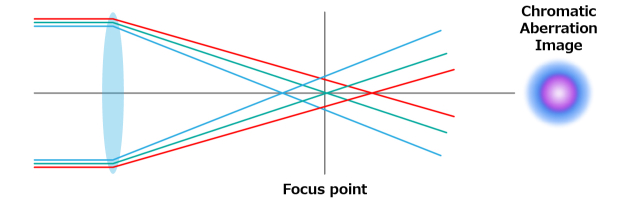
To correct this chromatic aberration, an achromatic lens – combining a concave lens and a convex lens – is used (Fig. 3).
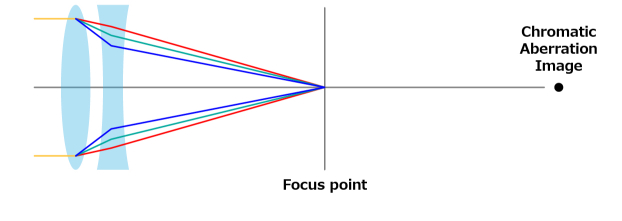
*Chromatic aberration is either axial chromatic aberration, as above, or transverse chromatic aberration. There are also five types of monochromatic aberration, including spherical aberration.
Alps Alpine’s Achromatic Lenses
The use of achromatic lenses to overcome chromatic aberration is an already-known method. Alps Alpine created a compact 2mm-diameter aspherical achromatic lens using high-precision glass molding and glass bonding technology built up over many years.
⌀2mm + ⌀2mm Achromatic Lens
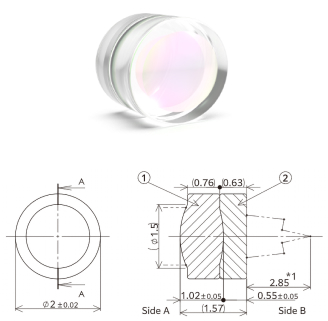
| Supported wavelengths | 440-660nm |
|---|---|
| Effective diameter (beam diameter) | 1.4mm on collimated side (at effective NA) |
| Effective NA | 0.172 (full angle approx. 19.8°; half angle approx. 9.9°) |
| Lens diameter | 1.5mm |
| Focal length | 4mm (@587.6nm) |
| Working distance | 2.85mm (adjustment expected) |
| Dimensions | ⌀2mm × t 1.57mm |
Aspherical surface bonding allows correction of not just chromatic aberration, but also spherical aberration.


Comparing an image with and without correction, we see the right-hand side, without an achromatic lens, is red-tinged.
We are also currently in the process of developing a 1mm-diameter + 1mm-squared achromatic lens – the industry’s smallest class. In this way, Alps Alpine’s glass bonding and alignment technology enables both size reductions and bonding of various shapes, allowing flexibility in accommodating customer requirements for such parameters as shape, light source height, optical path length and package dimensions.
⌀1mm + □1mm Achromatic Lens
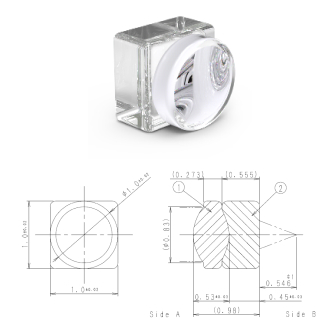
| Supported wavelengths | 440-660nm |
|---|---|
| Effective diameter (beam diameter) | 0.8mm on collimated side (at effective NA) |
| Effective NA | 0.316 (full angle approx. 36.8°; half angle approx. 18.4°) |
| Lens diameter | 0.83mm |
| Focal length | 1.2mm (@520nm) |
| Working distance | 0.546mm (adjustment expected) |
| Dimensions | □1.00mm × t 0.98mm |
This image gives you an idea of the relative sizes of 2mm-diameter and 1mm-squared achromatic lenses alongside the tip of a 0.5mm-diameter mechanical pencil.
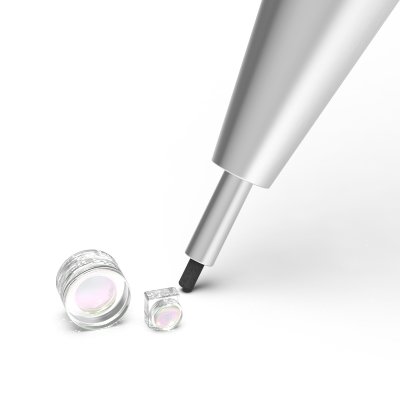
Alps Alpine's Achromatic Lens Usage Sample
Smaller, lighter lenses enable use in a variety of applications. One example is augmented reality (AR) glasses. Alps Alpine achromatic lenses or collimator lenses could be fitted into an ultra-compact RGB laser light source to enable viewing of video through AR glasses.
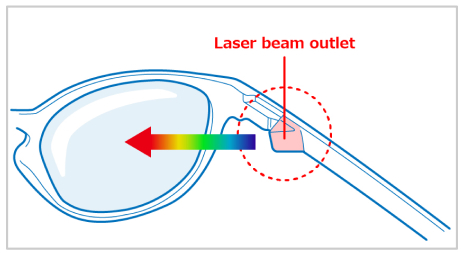
Other possible applications where compact size and light weight are required include compact projectors for mobile devices.
Past articles
-

Understanding TACT Switch™ Product Specifications
April, 2025 -

Characteristics Produced by TACT Switch™ Metal Contacts
April, 2024 -

haptic reactor AFR Series / AFDU Series
March, 2024 -

Achromatic Lenses
March, 2023 -

TACT Switch™ Products with a Long Service Life
May, 2022 -

Internal Resistor Type Detector Switches
November, 2021 -

Features of Force Sensors
March, 2021 -

Air Pressure and Water Pressure Sensors
February, 2021 -

Pressure Sensors
January, 2021 -

haptic reactor AFT Series
November, 2020 -

TACT Switch™ – Realizing Quiet Operation
October, 2020 -

TACT Switch™ – Features and Effects of Middle-Stroke Types
September, 2020 -

TACT Switch™ – Middle-Stroke Types
July, 2020 -

Stick Controllers (ThumbPointer™)
May, 2020 -

Encoders
April, 2020 -

Potentiometer Varieties
March, 2020 -

Potentiometers – What Are They?
February, 2020 -

Alps Alpine's Humidity Sensors
January, 2020 -

Features of Spring Contacts
September, 2019 -

Spring Contacts – What Are They?
August, 2019 -

Features of Slide Switches
July, 2019 -

Detector Switch Varieties
July, 2019 -

A Special Feature of Detector Switches
June, 2019 -

Features of Resistive Position Sensors
April, 2019 -

Resistive Position Sensors
April, 2019 -

Angle Sensor
November, 2018 -

2-in-1 Encoder with Variable Magnetic Pole Pitch
October, 2018 -

Magnetic Sensor
September, 2018 -

TACT Switch™ as a Multifunctional Key
July, 2018 -

Factors Determining the Feel of a Switch
June, 2018 -

Having Trouble with Contamination of Electrical Contacts?
May, 2018
